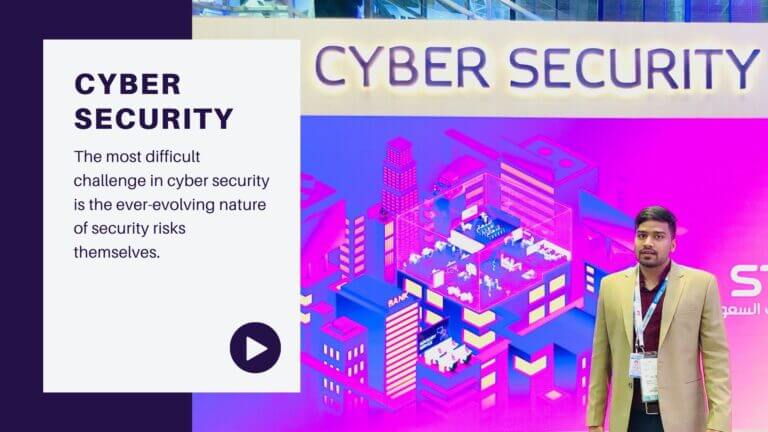In the current world that is run by technology and network connections, it is crucial to know what is cyber security and to be able to use it effectively. Systems, important files, data, and other important virtual things are at risk if there is no security to protect it. Whether it is an IT firm not, every company has to be protected equally. With the improvement of the new technology in cyber security, the attackers also do not fall behind. They are using better and better hacking techniques and target the weak points of many companies out there.
Cyber security is a process of protecting sensitive data, networks, and software applications from the cyber attacks. Cyber attacks can be considered as an exploitation of resources, unauthorized access to the systems, ransomware attacks to encrypt data and extract money.
The days when it was enough to only have a strong password are long gone, and our personal and work data is exposed to many dangers. Why is it so important to protect it?
Why is Cyber Security important?
Not only it is crucial to know what is cyber security but also to understand why it is important. The game has been taken to another level by hackers, so organizations and their employees should know what is at risk if it’s not dealt with.
The cost of cyber threats is at an all-time high and the breaches of security systems can be undiscovered for months. For example, advanced persistent threats make continues actions to hack into the computer systems, gain access and remain inside for months tracking and monitoring organizations’ actions before they are noticed.
Having the right cyber security measures is the key defense against this kind of errors and malicious attacks, so knowing what is cyber security and why is it important is crucial to everyone.
What is the Key Concept of Cyber security?
Cyber security on its own has a very broad term and may have many definitions the revolve around the digital world. To understand the cyber security term three fundamental concepts are known as “The CIA Triad”.
The CIA Triad is an acronym of words like confidentiality, integrity, and availability. This model is designed to guide the organization with the policies of cyber security.
- Confidentiality. It is the process that rules out access to information to certain people. It is a measure to restrict sensitive information from getting into the wrong hands. In an organization, people are allowed or denied access to information according to their occupation. This kind of people get proper training and rules about the sharing confidential secrets, secure their accounts with properly strong passwords. Some of the key points of what is cybers ecurity made of are 2FA (two-factor authentication, data classification, data encryption, biometric verification, etc.
- Integrity. The process of integrity assures that the data in the system is consistent, verified, accurate and trustworthy. It means that the data cannot be changed, altered, deleted, or accessed without certain permission. This is why it is important to keep track of file permissions and user access. Another important thing to maintain data integrity is to have a secured backup. Cloud backups are one of the most trustworthy at this time.
- Availability. In terms of necessary components like hardware, networks, software, devices, and equipment, availability means that it all should be upgraded and maintained. The reason why it is important is that it provides smooth functioning and access to the data without any disruptions. Utilities like firewalls, proxy servers, back up solutions, and recovery plans are key points against cyber threats.
What Are The Elements of Cyber security?
Now that we reviewed the concept of what is cyber security and why is it so important, it is significant to learn about its’ elements. A strong cyber security network consists of many features:
- Application security. Website applications are common ground for cybercriminals and its’ vulnerability may cause a lot of trouble. Organizations that run a business on the websites must ensure their safety to protect their customers, their financials and personal information.
- Network security. It is the process of protecting servers and solving security issues in servers, hosts, devices, and internet services. Network security is done by protecting the usability and integrity of data on the network.
- Operational security. It protects the organization’s main functions. Operational security is important to track critical information and the assets that interact with it to identify vulnerabilities.
- End-user education. Companies’ cyber security strategy is as strong as the weakest link of the team. This is why every employee must know what measures are needed to be done and how to spot incoming threats.
- Management involvement. The last but not least important element of what is cyber security it the commitment of organizations management to be prepared to invest in cyber security. The supervisors need to understand that it is important to hire qualified people, acquire appropriate cyber security resources and technology.
What are the most common cyber security threats?
We already talked about the results that come from a lack of cyber security. It can cause financial, medical, governmental issues or even disasters. But what exactly causes them? Cybercriminals become highly sophisticated when it comes to their tactics, therefore they create many threats or “traps” that can lure innocent people into cyber-threats.
- Virus. The most popular one that probably everyone has run into throughout their lives. Although many refer to every cyber security threat as a virus, it is not entirely true. The virus is a piece of malicious code that is loaded into a computer without users’ permission. It can attach itself to other files and spread throughout the network. It is one of the main goals of what is cyber security doing – to prevent this kind of threat.
- DDoS (distributed denial-of-service). This threat attempt to disrupt normal web traffic and take a site offline by flooding the system with more requests than it can handle.
- Malware. This is a term that stands for a program that is created to harm a computer. It encompasses viruses, spyware, trojans, social engineering, and worms.
- Worms. No, it’s not a game that we all used to love. It is a similar threat to a virus. It can self-replicate just like a virus, but it doesn’t need to attach itself to a computer program. They look for vulnerabilities in a computer and report them to their creator, which takes actions accordingly.
- Trojan. Another popular threat that most likely everyone heard of. It is a type of malware that disguises itself as legitimate software. It can be in the shape of virus removal programs but instead performs malicious activity when installed and run.
- Social engineering. It is a threat that is used to deceive and manipulate users to obtain their information and gain access to their computer. This is achieved through malicious links or by physically gaining access to the computer. This can cause huge problems for many organizations if they are not aware of what is cyber security.
- Phishing. It is a form of social engineering threat, that tries to acquire users’ sensitive or confidential information.
Spyware. It monitors your computer activity and collects personal information. Spyware or adware can be installed to a device through malicious links, software, or attachments. - Ransomware. This can be considered as the fastest-growing cyber threat. It is a type of malware that demands payment after encrypting the users’ files, making them inaccessible. It should be noted that paying the ransom does not guarantee the recovery of encrypted data, so be careful.
- MITM (man in the middle). This threat occurs when the user exposes himself to the un-secure network. It is called MITM because the cybercriminal inserts himself between the user and the server. The user will pass the information through the hacker unknowingly.
- Sequel injection. It happens when the attacker inserts malicious code into a server that uses Structured Query Language. Sequel injections are only successful when security vulnerability exists. If it does, the attack will force the server to provide access or to modify data.
By now you should have a better understanding of what is cyber security trying to do. Its’ job is to prevent all these threats reaching the users and by the looks of it – there is plenty of threats to eliminate. There are many more cyber-attacks out there but in this list are the ones that are mostly run into.
How to Avoid Cyber Security Attacks?
With so many threats out there it is essential to learn how to protect yourself from cyber security breaches. To protect yourself from such risks it is important to have a strong cyber security foundation that will mitigate the risk of an attack. Also, there are some tips should be helpful to everyone using the network and all kinds of internet devices:
- Install and regularly update antivirus software for every computer used in business, home, or other places. Do a little research and find the best protection provider on the internet and don’t buy the cheapest software.
- Protect your internet connection by using a firewall.
- Make backup copies for important data and keep them safe.
- Train employees or family members about cyber security and its’ principles.
- Regularly change passwords and use strong ones. A strong password contains lower-case, capital letters and numbers. It is recommended to not make it a word, just a random combination.
- Regularly update computer software and operating systems.
- Secure the network.
Cyber security is one of the most important aspects of the fast-paced growing digital world. The threats of it are hard to deny, so it is crucial to learn how to defend from them and teach others how to do it too. If you want to learn more about what is cyber security and how to deal with cyber criminals hop into our courses section and become a hero in the digital platforms.





